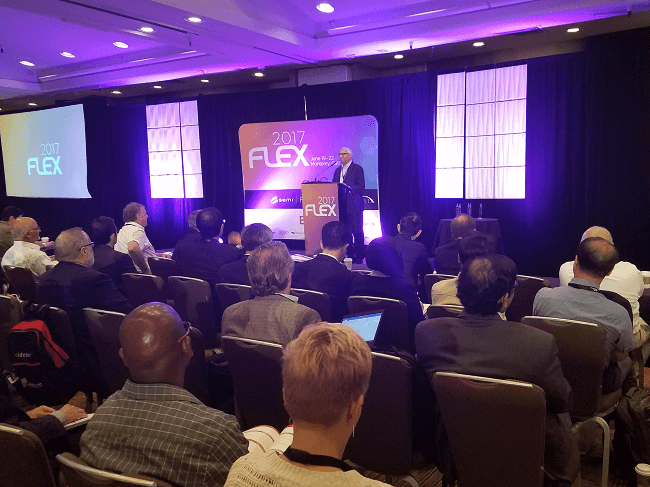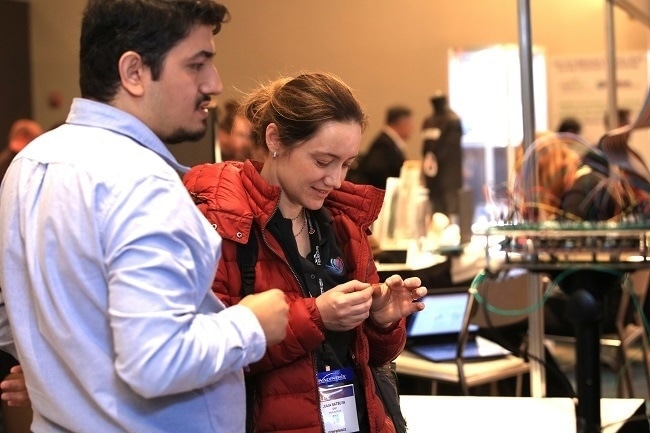In this interview, Melissa Grupen-Shemansky, President of SEMI-FlexTech, a SEMI Strategic Association Partner talks to AZoSensors about what to expect at the upcoming FLEX Conference & Exhibition.
“Materials to Markets” is one of the main events and will cover market applications such as power, smart packaging, biosensors and many more.
SEMI’s annual FLEX Conference & Exhibition returns to Monterey, California, February 12-15, 2018 with the promise of covering “Materials to Markets” for flexible hybrid electronics (FHE). What can we expect?
“Material to Markets”, chosen by our industry-based conference executive committee, best describes the breadth of 2018FLEX conference topics.
The conference goes into depth on substrates, inks and pastes, printers and die-attach equipment and the processes for using them. Plus, it covers market applications such as power, smart packaging, 3D printing, and flexible displays and biosensors, to name a few.
Fundamentally, the building blocks of so many next-generation electronics come down to new materials and processes that the traditional electronics supply chain is being rewritten into more of a supply network. New products and applications are inextricably tied to new materials and new processing methods.
These are all highlighted in the event’s agenda and form the basis of why we see flexible hybrid electronics as a future differentiator for the electronics industry.
The conference is being co-located with the MEMS & Sensors Technical Congress. Can you tell us more about that?
The MEMS & Sensors Technical Congress (MSTC) has been a stand-alone event for the past 15 years, originally focused only on MEMS.
However, in the last few years, the Congress began covering the sensors sector organized by the MEMS & Sensors Industry Group (MSIG). MSIG became a SEMI strategic association partner, similar to FlexTech. That was when we started to discuss the advantages of both events to co-locate and share keynotes, short courses, and a location.
It was clear that co-locating would maximize the technical exchanges for many of our attendees, as the FLEX Conference has for years covered flexible sensor technology, FHE, MEMS and driving some of the newest electronics product developments with sensors.
Last year’s short course on Sensors and Sensors Systems was so popular we are repeating it again this year.
We believe that co-location brings more opportunities to collaborate with a complementary group of topics and technologists and maximizes chances for cross-technology advancements – a win-win situation for all.
Qualcomm is an excellent example of a company that is developing some of the most innovative technologies in all of these sectors and is a key contributor to both events.

Can you give an overview of the issues and developments that will be presented at the conference?
The event focus can be broken down into 9 major technology track areas: flexible displays, communications, flexible products, IC integration, manufacturing on flex, MedTech, printed technologies, sensors, and MEMS. Each track is made up of at least one short course, multiple sessions or individual talks and networking events.
The ongoing challenges in working with thin silicon and die placement on flexible substrates is a popular topic the last few years. This year we will hear from Jabil, Flex, Multek, PARC, CONNECTEC Japan, UCLA and Universal Instruments on placement and attachment techniques, including anisotropic bonding materials.
The topic of 3D printing of both full devices and as an additive process continues to draw a lot of attention. This year we will hear about advancements from NASA, TechSearch, UTRC, Meyer Berger, Optomec and nScrypt on the topic.
Flexible display technology continues to develop and micro-OLED is an intriguing path being followed by some of the largest manufacturers.
In this session, LG Display is providing the opening talk, followed by UDC, Clearink Displays, Atom Optoelectronics, and Display Supply Chain Consultants. Flexible displays will likely be referenced throughout the event as it remains one of those technologies that would open markets and potentially change how and when data and information are provided to us.
As usual, the advancements being made by government investment into the technology will be featured with presentations from US Army R&D Center Picatinny, Boeing, and NextFlex.
A new panel on how to identify opportunities for small businesses to partner with DOD in the FHE will be held with SI2 Technologies, DOD, The Army Armament Research Development and Engineering, and the Air Force Research Lab’s Airman Systems Directorate.
MSTC 2018 is divided into sessions on Health & Wellness, Materials Characterization, Applications and Emerging Technologies, interspersed with keynotes and networking opportunities. Keynotes include Frost & Sullivan, with an analysis of current market trends, and Knowles, with a talk entitled, Emerging Audio Applications and Architecture.
Other presenting companies include mCube, NXP Semiconductors, Weill Cornell Medicine, Knowles, ULVAC, Quantum Analytics, Murata, TDK/Icense, and Terahertz Device.
Those are just a few of the speakers and topics covered at 2018FLEX and MSTC2018. The full agenda is available online – 2018FLEX.com - and on our App, along with full abstracts.
The 2018FLEX App has a useful feature where all the talks are also divided into topical TRACKS of Flex Displays, Communications, Flexible Products, IC integration, Manufacturing on Flex, MedTech, Printed, Sensors and MEMS. Download that from Apple App Store or Google Play.
One of the opening keynotes will feature NASA. What are they going to discuss? Can you tell us who are some of the other keynote speakers?
Mayya Mayyappan is the chief scientist for Exploration Technology at NASA Ames Research Center and will be providing an overview of NASA’s In-Space Manufacturing (ISM) Initiative to provide the capability to reproduce or repair failed devices at the International Space Station (ISS). There is a dual attraction of this talk to our attendees.
First, flexible and printed electronics is key to meeting demands on the ISS for gas, bio and radiation sensors, batteries, supercapacitors, memory devices, RF antennas and many other components. Secondly, the idea of additive manufacturing as a way to reproduce any device on an as-needed basis in a zero-tolerance environment such as the ISS, challenges the nature of manufacturing. The talk and NASA’s findings promises to be one of those oft-referred to throughout the event and beyond.
The keynote lineup provides insights into all of the key FHE Markets: Panasonic will provide an overview on power requirements, considerations and promises for today’s electronic devices.
Draper Labs will use drones as a case study, Thin Film Electronics on smart packaging, NASA on 3D printing, Cortera Neurotechnologies on flexible biosensors, Luminit on human-machine interfaces, and IHS Markit on flexible displays and other FHE markets.

What can attendees expect from the full-service exhibition at the event and the FLEXtalks?
The exhibit floor will again be an excellent location for spotting trends, hearing about new materials, advancements and collaborating with industry players. There are several exhibitors debuting their products and services at 2018FLEX and MSTC 2018, including, Tango Systems, Nanotronics, PeerGroup, Unisem, Fraunhofer Institute, and Seria Corporation, just to name a few.
SEMI is bringing its Smart Starts Here exhibit, a journey through teardowns of several popular electronic devices – a special place for the electronics geek in all of us.
We will also be returning the popular series of FLEXTalks to the exhibit hall. These talks let attendees get more intimate views of advancements that were only discussed in the technical conference.
Those on the agenda this year include: Bonbouton, Boeing, PARC, Graftworx, American Semiconductor, Interlink Electronics, Berkeley, AerNos, and Jabil.
What is instore for the future of SEMI-FlexTech and SEMI-MSIG?
Both organizations have a full calendar for 2018, with technical events around the globe. We will continue to manage and expand technology funding programs, market statistics products and industry standards and guideline activities.
We will continue to leverage SEMI programs in work-force development, standards and in environmental, health and safety (EH&S). Both organizations are hosting programs at SEMICON West 2018 in San Francisco in July, including MEMS and Sensor pavilions, programs and the on-floor TechXpots.
We have a busy year planned and look forward to continuing to help our technology communities to connect, collaborate and innovate.
About Melissa Grupen-Shemansky, Ph.D.
Dr. Melissa Grupen-Shemansky oversees SEMI-FlexTech, including the flexible hybrid electronics (FHE) and Nano-Bio Manufacturing Consortium (NBMC) R&D programs and governing and technology advisory councils.
 She has a strong background in R&D, manufacturing, business development, and technology strategy. Grupen-Shemansky also serves as technical advisor to SEMI’s Advanced Packaging initiative.
She has a strong background in R&D, manufacturing, business development, and technology strategy. Grupen-Shemansky also serves as technical advisor to SEMI’s Advanced Packaging initiative.
Disclaimer: The views expressed here are those of the interviewee and do not necessarily represent the views of AZoM.com Limited (T/A) AZoNetwork, the owner and operator of this website. This disclaimer forms part of the Terms and Conditions of use of this website.
In this interview, Melissa Grupen-Shemansky, President of SEMI-FlexTech, a SEMI Strategic Association Partner talks to AZoSensors about what to expect at the upcoming FLEX Conference & Exhibition.
“Materials to Markets” is one of the main events and will cover market applications such as power, smart packaging, biosensors and many more.
SEMI’s annual FLEX Conference & Exhibition returns to Monterey, California, February 12-15, 2018 with the promise of covering “Materials to Markets” for flexible hybrid electronics (FHE). What can we expect?
“Material to Markets”, chosen by our industry-based conference executive committee, best describes the breadth of 2018FLEX conference topics.
The conference goes into depth on substrates, inks and pastes, printers and die-attach equipment and the processes for using them. Plus, it covers market applications such as power, smart packaging, 3D printing, and flexible displays and biosensors, to name a few.
Fundamentally, the building blocks of so many next-generation electronics come down to new materials and processes that the traditional electronics supply chain is being rewritten into more of a supply network. New products and applications are inextricably tied to new materials and new processing methods.
These are all highlighted in the event’s agenda and form the basis of why we see flexible hybrid electronics as a future differentiator for the electronics industry.
The conference is being co-located with the MEMS & Sensors Technical Congress. Can you tell us more about that?
The MEMS & Sensors Technical Congress (MSTC) has been a stand-alone event for the past 15 years, originally focused only on MEMS.
However, in the last few years, the Congress began covering the sensors sector organized by the MEMS & Sensors Industry Group (MSIG). MSIG became a SEMI strategic association partner, similar to FlexTech. That was when we started to discuss the advantages of both events to co-locate and share keynotes, short courses, and a location.
It was clear that co-locating would maximize the technical exchanges for many of our attendees, as the FLEX Conference has for years covered flexible sensor technology, FHE, MEMS and driving some of the newest electronics product developments with sensors.
Last year’s short course on Sensors and Sensors Systems was so popular we are repeating it again this year.
We believe that co-location brings more opportunities to collaborate with a complementary group of topics and technologists and maximizes chances for cross-technology advancements – a win-win situation for all.
Qualcomm is an excellent example of a company that is developing some of the most innovative technologies in all of these sectors and is a key contributor to both events.

Can you give an overview of the issues and developments that will be presented at the conference?
The event focus can be broken down into 9 major technology track areas: flexible displays, communications, flexible products, IC integration, manufacturing on flex, MedTech, printed technologies, sensors, and MEMS. Each track is made up of at least one short course, multiple sessions or individual talks and networking events.
The ongoing challenges in working with thin silicon and die placement on flexible substrates is a popular topic the last few years. This year we will hear from Jabil, Flex, Multek, PARC, CONNECTEC Japan, UCLA and Universal Instruments on placement and attachment techniques, including anisotropic bonding materials.
The topic of 3D printing of both full devices and as an additive process continues to draw a lot of attention. This year we will hear about advancements from NASA, TechSearch, UTRC, Meyer Berger, Optomec and nScrypt on the topic.
Flexible display technology continues to develop and micro-OLED is an intriguing path being followed by some of the largest manufacturers.
In this session, LG Display is providing the opening talk, followed by UDC, Clearink Displays, Atom Optoelectronics, and Display Supply Chain Consultants. Flexible displays will likely be referenced throughout the event as it remains one of those technologies that would open markets and potentially change how and when data and information are provided to us.
As usual, the advancements being made by government investment into the technology will be featured with presentations from US Army R&D Center Picatinny, Boeing, and NextFlex.
A new panel on how to identify opportunities for small businesses to partner with DOD in the FHE will be held with SI2 Technologies, DOD, The Army Armament Research Development and Engineering, and the Air Force Research Lab’s Airman Systems Directorate.
MSTC 2018 is divided into sessions on Health & Wellness, Materials Characterization, Applications and Emerging Technologies, interspersed with keynotes and networking opportunities. Keynotes include Frost & Sullivan, with an analysis of current market trends, and Knowles, with a talk entitled, Emerging Audio Applications and Architecture.
Other presenting companies include mCube, NXP Semiconductors, Weill Cornell Medicine, Knowles, ULVAC, Quantum Analytics, Murata, TDK/Icense, and Terahertz Device.
Those are just a few of the speakers and topics covered at 2018FLEX and MSTC2018. The full agenda is available online – 2018FLEX.com - and on our App, along with full abstracts.
The 2018FLEX App has a useful feature where all the talks are also divided into topical TRACKS of Flex Displays, Communications, Flexible Products, IC integration, Manufacturing on Flex, MedTech, Printed, Sensors and MEMS. Download that from Apple App Store or Google Play.
One of the opening keynotes will feature NASA. What are they going to discuss? Can you tell us who are some of the other keynote speakers?
Mayya Mayyappan is the chief scientist for Exploration Technology at NASA Ames Research Center and will be providing an overview of NASA’s In-Space Manufacturing (ISM) Initiative to provide the capability to reproduce or repair failed devices at the International Space Station (ISS). There is a dual attraction of this talk to our attendees.
First, flexible and printed electronics is key to meeting demands on the ISS for gas, bio and radiation sensors, batteries, supercapacitors, memory devices, RF antennas and many other components. Secondly, the idea of additive manufacturing as a way to reproduce any device on an as-needed basis in a zero-tolerance environment such as the ISS, challenges the nature of manufacturing. The talk and NASA’s findings promises to be one of those oft-referred to throughout the event and beyond.
The keynote lineup provides insights into all of the key FHE Markets: Panasonic will provide an overview on power requirements, considerations and promises for today’s electronic devices.
Draper Labs will use drones as a case study, Thin Film Electronics on smart packaging, NASA on 3D printing, Cortera Neurotechnologies on flexible biosensors, Luminit on human-machine interfaces, and IHS Markit on flexible displays and other FHE markets.

What can attendees expect from the full-service exhibition at the event and the FLEXtalks?
The exhibit floor will again be an excellent location for spotting trends, hearing about new materials, advancements and collaborating with industry players. There are several exhibitors debuting their products and services at 2018FLEX and MSTC 2018, including, Tango Systems, Nanotronics, PeerGroup, Unisem, Fraunhofer Institute, and Seria Corporation, just to name a few.
SEMI is bringing its Smart Starts Here exhibit, a journey through teardowns of several popular electronic devices – a special place for the electronics geek in all of us.
We will also be returning the popular series of FLEXTalks to the exhibit hall. These talks let attendees get more intimate views of advancements that were only discussed in the technical conference.
Those on the agenda this year include: Bonbouton, Boeing, PARC, Graftworx, American Semiconductor, Interlink Electronics, Berkeley, AerNos, and Jabil.
What is instore for the future of SEMI-FlexTech and SEMI-MSIG?
Both organizations have a full calendar for 2018, with technical events around the globe. We will continue to manage and expand technology funding programs, market statistics products and industry standards and guideline activities.
We will continue to leverage SEMI programs in work-force development, standards and in environmental, health and safety (EH&S). Both organizations are hosting programs at SEMICON West 2018 in San Francisco in July, including MEMS and Sensor pavilions, programs and the on-floor TechXpots.
We have a busy year planned and look forward to continuing to help our technology communities to connect, collaborate and innovate.
About Melissa Grupen-Shemansky, Ph.D.
Dr. Melissa Grupen-Shemansky oversees SEMI-FlexTech, including the flexible hybrid electronics (FHE) and Nano-Bio Manufacturing Consortium (NBMC) R&D programs and governing and technology advisory councils.
 She has a strong background in R&D, manufacturing, business development, and technology strategy. Grupen-Shemansky also serves as technical advisor to SEMI’s Advanced Packaging initiative.
She has a strong background in R&D, manufacturing, business development, and technology strategy. Grupen-Shemansky also serves as technical advisor to SEMI’s Advanced Packaging initiative.